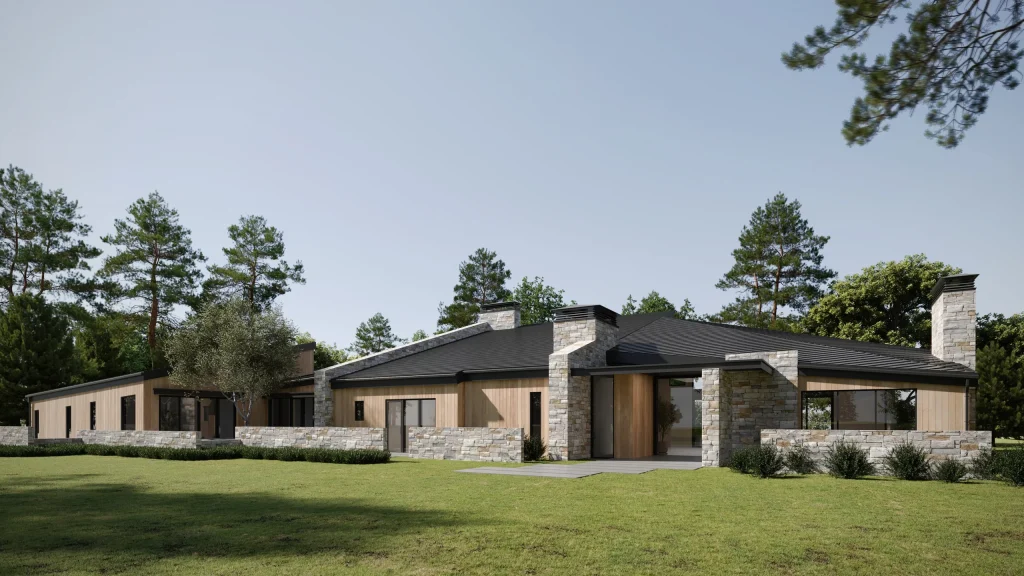Architectural visualization, including photorealistic architectural rendering, has become an indispensable tool for architects, aiding in the communication of design concepts to clients, stakeholders, and even construction teams. In today’s competitive landscape, photorealistic renderings can make all the difference in conveying the vision and aesthetics of a project. Here are five types of photorealistic architectural visualizations that architects absolutely need:
1.Exterior Renderings:
These are perhaps the most common type of architectural visualization. Exterior renderings provide a realistic depiction of how a building will look from the outside once it’s completed. From materials and textures to lighting and landscaping, these renderings help clients envision the final product in its intended environment. Whether it’s a sleek modern skyscraper or a quaint residential home, exterior renderings capture the essence of the design and its integration into the surroundings.
2. Interior Renderings:
Just as important as exterior renderings are interior renderings. These visualizations offer a glimpse into the interior spaces of a building, showcasing the layout, design elements, and ambiance. From the arrangement of furniture to the play of natural and artificial light, interior renderings help clients understand the functionality and aesthetics of each room. Whether it’s a cozy living room, a state-of-the-art kitchen, or a luxurious hotel lobby, interior renderings bring spaces to life before they’re even built.
3. Aerial Renderings:
Aerial renderings provide a bird’s-eye view of the entire property or development, offering a comprehensive perspective of the site layout and surrounding context. These visualizations are invaluable for showcasing the relationship between different buildings, outdoor spaces, and amenities. Whether it’s a residential community, a commercial complex, or an urban redevelopment project, aerial renderings help stakeholders grasp the overall design and spatial organization from a macro level.
4. Daylight Studies:
Natural light plays a crucial role in architectural design, influencing everything from building orientation to interior atmosphere. Daylight studies utilize photorealistic renderings to simulate how natural light will interact with the built environment throughout the day. By visualizing the changing patterns of sunlight and shadow, architects can optimize window placement, shading devices, and interior finishes to enhance comfort and energy efficiency. These studies also allow clients to appreciate the dynamic interplay between architecture and nature.
5. Nighttime Visualizations:
The magic of architectural design doesn’t end when the sun goes down. Nighttime visualizations capture the allure of a building illuminated against the backdrop of darkness. From dramatic façade lighting to sparkling cityscapes, these renderings highlight the architectural features that come alive after dusk. Whether it’s a vibrant urban nightlife scene or a serene suburban setting, nighttime visualizations evoke a sense of ambiance and character that adds another dimension to the design narrative.
In conclusion,
photorealistic architectural visualization is a powerful tool that empowers architects to convey their design vision with clarity and impact. From exterior and interior renderings to aerial views, daylight studies, and nighttime visualizations, each type serves a distinct purpose in communicating the essence of a project. By harnessing the capabilities of modern rendering technology, architects can engage clients, inspire stakeholders, and ultimately bring their architectural dreams to life.
FAQs (Frequently Asked Questions)
- Why are photorealistic architectural renderings important for architects?
- Photorealistic architectural renderings help architects effectively communicate their design concepts to clients, stakeholders, and construction teams. They provide a realistic representation of how a building will look and feel, allowing everyone involved to visualize the final product before it’s constructed.
- What software is commonly used to create photorealistic architectural renderings?
- There are several software options available for creating photorealistic architectural renderings, including Autodesk 3ds Max, SketchUp with V-Ray, Rhino with V-Ray, Blender, and Lumion, among others. Each software has its own strengths and features, catering to different workflows and preferences.
- How long does it take to produce a photorealistic architectural rendering?
- The time required to produce a photorealistic architectural rendering depends on various factors, including the complexity of the project, the level of detail required, and the skill level of the artist. Simple renderings may take a few hours to complete, while more complex ones could take several days or even weeks.
- Can photorealistic architectural renderings be modified during the design process?
- Yes, one of the advantages of photorealistic architectural renderings is their flexibility. Architects can make changes to the design based on client feedback or evolving project requirements, and these changes can be reflected in the renderings to ensure they accurately represent the latest design iterations.
- Are photorealistic architectural renderings an additional cost for clients?
- While photorealistic architectural renderings do incur a cost, they are often considered a worthwhile investment in the design and marketing of a project. Clients benefit from being able to visualize the proposed design in detail before construction begins, potentially avoiding costly changes or misunderstandings later in the process.
- How can clients provide feedback on photorealistic architectural renderings?
- Clients can provide feedback on photorealistic architectural renderings through meetings, emails, or dedicated rendering review sessions. It’s important for architects and rendering artists to actively solicit feedback to ensure that the renderings accurately reflect the client’s vision and expectations.
- What role do photorealistic architectural renderings play in the marketing of a project?
- Photorealistic architectural renderings are essential marketing tools for architects and developers. They help attract potential buyers or investors by showcasing the design, features, and amenities of a project in a visually compelling way. High-quality renderings can create excitement and anticipation around a project, ultimately driving sales and investment.




